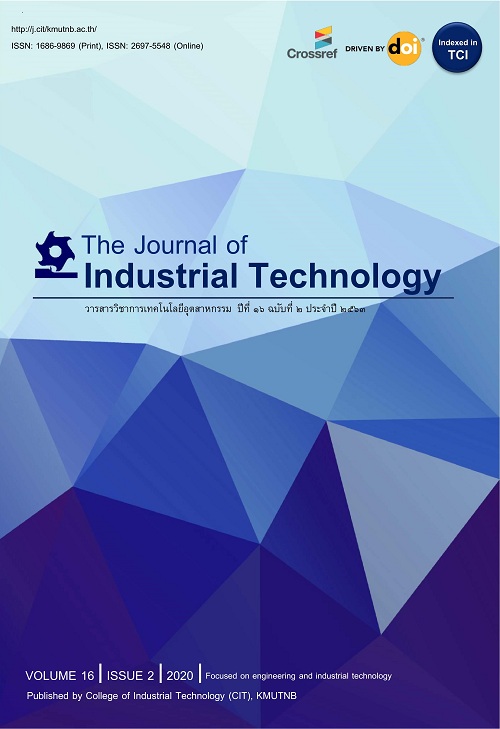Study on Optimum Thickness of Post-Tension Concrete Flat Slab with Band Beam
การศึกษาเพื่อหาค่าความหนาที่เหมาะสมสำหรับแผ่นพื้นไร้คานคอนกรีตอัดแรงภายหลังชนิดมีคานกว้าง
Abstract
งานวิจัยนี้นำเสนอการศึกษาเพื่อหาความหนาที่เหมาะสมสำหรับแผ่นพื้นไร้คานคอนกรีตอัดแรงภายหลังชนิดมีคานกว้าง โดยใช้หลักการหาความเหมาะสมด้วยระเบียบวิธีฟังก์ชันพหุนาม ในการวิเคราะห์โครงสร้างใช้วิธีโครงข้อแข็งเสมือน โดยใช้โปรแกรม ADAPT-PT/RC 2015 ในการช่วยคำนวณ ความกว้างของคานที่ศึกษามี 3 กรณี คือ 1/3 1/4 และ 1/5 ของความกว้างแผ่นพื้น ความยาวช่วงของพื้นในแต่ละกรณีเท่ากับ 15 18 และ 20 เมตร ตามลำดับ สำหรับน้ำหนักบรรทุกจรจะกำหนดให้แปรเปลี่ยนไปตามประเภทการใช้สอยของอาคาร ได้แก่ ส่วนพักอาศัย ส่วนสำนักงาน และส่วนที่จอดรถ มีค่าเท่ากับ 200 300 และ 400 กิโลกรัมต่อตารางเมตร ตามลำดับ โดยมีการพิจารณาน้ำหนักบรรทุกคงที่ ที่นอกเหนือจากน้ำหนักของพื้นเอง 120 และ 300 กิโลกรัมต่อตารางเมตร จากนั้นนำผลที่ได้จากการออกแบบไปหาฟังก์ชันพหุนาม เพื่อหาค่าความหนาที่เหมาะสมเพื่อเป็นข้อมูลให้วิศวกรสามารถนำไปเป็นแนวทางออกแบบเบื้องต้นและประมาณราคา จากการศึกษาพบว่าค่าสัมประสิทธิ์สหสัมพันธ์ (R2) มีค่าเท่ากับ 1.0 และสรุปผลได้ว่า สำหรับส่วนพักอาศัย ส่วนสำนักงาน และส่วนที่จอดรถ กรณีความกว้างของคานเท่ากับ 1/3 ของความกว้างพื้น อัตราส่วนความยาวช่วงต่อความหนาของพื้นที่เหมาะสม เท่ากับ 34 32 และ 33 ตามลำดับ กรณีความกว้างของคานเท่ากับ 1/4 ของความกว้างแผ่นพื้น อัตราส่วนความยาวช่วงต่อความหนาของพื้นที่เหมาะสม เท่ากับ 33 31 และ 32 ตามลำดับ กรณีความกว้างของคานเท่ากับ 1/5 ของความกว้างแผ่นพื้น อัตราส่วนความยาวช่วงต่อความหนาของพื้นที่เหมาะสม เท่ากับ 31 29 และ 30
This paper aims to find the optimum thickness for post-tensioned slabs with band beam using the polynomial optimization method. In the structural analysis, the equivalent frame method using the ADAPT-PT/RC 2015 software is used. In this study, three widths of the band beam were used such as 1/3, 1/4 and 1/5 of the slab width. The span length of the floor slab in each case was 15, 18 and 20 meters, respectively. The value of live load was 200, 300 and 400 kg/m2 which depending on the type of building's usability, including residential, office and parking areas, were used. In addition to the weight of the floor itself, the superimposed dead loads such as 120 and 300 kg/m2 were taken into account in the analysis process. The results of the design are then used to find the appropriate thickness using the polynomial optimization method to provide information for engineers to guide the design and estimate the cost. Based on the analysis, it was found that the correlation coefficient (R2) was 1.0. For residential, office and parking areas, the width of the band beam is 1/3 of the floor width, the suitable ratio of span length to slab’s optimum thickness are 34, 32, and 33, respectively. For the width of the band beam is 1/4 of the width of the slab, the suitable ratio of span length to slab’s optimum thickness are 33, 31, and 32, respectively. In the case of band beam width equal to 1/5 of the width of the slab, the suitable ratio of span length to slab’s optimum thickness is 31, 29 and 30.
Keywords
[1] P.R. Gupta, Post-tensioning manual, 6th Ed., The Post-Tensioning Institute, Phoenix, AZ, USA. 2006, pp.174.
[2] RAM Concept V8i, RAM International., Available: https://www.bentley.com/en/
products/product-line/structural-analysis-software/ram-concept (Accessed on 24 May 2021)
[3] CSI SAFE 12, Computers and Structures Inc., Available: https://www.csiamerica.com/ products/safe (Accessed on 24 May 2021)
[4] C. Suchinda, A comparison of post- tensioned concrete flat slabs designing results between 2D equivalent frame method and 3D plate finite element method, The 13th National Convention on Civil Engineering, Proceeding, 2008, Art. No. STR-010. (in Thai)
[5] S. Tongarporn and C. Suchinda, A study to determine optimal thicknesses for post-tension concrete flat slab using 3D plate finite element, The 5th Annual Concrete Conference, Proceeding, 2009, Art. No. STR-7. (in Thai)
[6] W. Sanghitkul, Optimum design of post-tensioned flat plate, Thesis, Chulalongkorn University, Thailand, 1996. (inThai)
[7] A. Teeranupatana, Optimum design of post-tensioned flat plates by the simple method, Thesis, Chulalongkorn University, Thailand, 1999. (in Thai)
[8] ADAPT structural concrete software, ADATP-PT/RC 2015, Available: https://adaptsolutions.files.wordpress.com/2010/01/pt_rc_2015_user_manual_08282015_v1_0_final.pdf (Accessed on 24 May 2021)
[9] ACI 318-08, Building code requirements for structural concrete (ACI 318-08) and Commentary, 2008.
[10] EIT1008-38, Building code requirements for reinforced concrete by the strength design Method, 2015. (in Thai).
[11] Construction materials price index for November 2017, Economic Indices, Ministry of Commerce, 2017. (in Thai)
[12] Labor/operation index for quantities take-off and estimating the appraisal cost for construction work, The Comptroller General’s Department, Ministry of Finance, 2017. (in Thai)
DOI: 10.14416/j.ind.tech.2021.05.002
Refbacks
- There are currently no refbacks.






